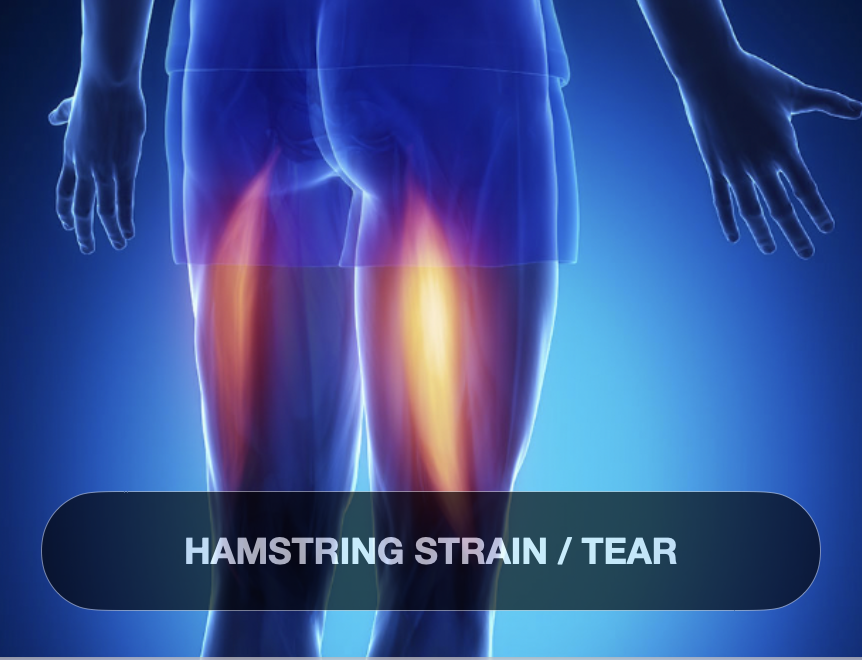Hamstring Strains/Tears
Introduction
Hamstring strains or tears are among the most common soft tissue injuries affecting athletes, particularly those engaged in sports requiring rapid acceleration, deceleration, and high-speed running. The hamstring muscle group, comprising the biceps femoris, semitendinosus, and semimembranosus, plays a critical role in knee flexion and hip extension. Strains range from minor muscle fiber disruptions to complete tears, significantly impacting function and athletic performance. A comprehensive understanding of their pathophysiology, classification, clinical presentation, and current evidence-based treatments is crucial for physiotherapists to optimize rehabilitation and minimize recurrence.
Definition
A hamstring strain/tear refers to the partial or complete disruption of muscle fibers in one or more of the hamstring muscles.
It commonly involves the muscle-tendon junction but can affect muscle belly or tendon proper.
Injuries range from mild overstretching with microscopic damage (Grade I) to complete rupture (Grade III).
It is a type of muscle strain injury, classified based on severity and tissue involvement.
Cause
Acute eccentric overload during rapid muscle lengthening, often seen during high-speed running, sprinting, or sudden acceleration/deceleration.
Sudden hip flexion combined with knee extension places excessive stretch on hamstrings, predisposing them to injury.
Muscle fatigue, inadequate warm-up, previous injury history, and poor flexibility increase risk.
Biomechanical factors such as strength imbalances (especially between quadriceps and hamstrings), altered running mechanics, and core instability also contribute.
Sports with high hamstring demand like soccer, track sprinting, football, and rugby show higher incidence rates.
Classification
Hamstring strains are commonly classified based on clinical and imaging findings:
Grade I (Mild): Small number of fibers torn, minimal strength loss, no or mild swelling, and pain.
Grade II (Moderate): Partial tear with significant fiber disruption, moderate pain, swelling, and reduced strength and function.
Grade III (Severe): Complete rupture or avulsion of the muscle or tendon, severe pain, swelling, bruising, and total loss of muscle function.
Anatomical location:
Proximal tendon avulsions: Often severe and may require surgery.
Muscle belly tears: Usually less severe but slower to heal.
Distal tendon tears: Less common but can affect knee flexion power.
Imaging modalities like MRI and ultrasound are key to accurate grading and treatment planning.
Signs and Symptoms
Acute onset of sharp, severe pain at the back of the thigh, often during sprinting or sudden movements.
Tenderness and swelling: Localized to injury site.
Bruising/ecchymosis: May develop within 24-48 hours.
Loss of strength and flexibility: Difficulty walking, running, or performing resisted knee flexion.
Palpable defect: In severe tears, a gap or lump may be felt in the muscle.
Pain on passive stretching of the hamstring muscles and resisted muscle contraction.
Functional impairment ranges from mild discomfort to complete inability to bear weight or ambulate normally.
Current Treatment Trends
Acute phase management:
POLICE principle: Protection, Optimal Loading, Ice, Compression, and Elevation to manage pain and swelling.
Early mobilization within pain limits to prevent stiffness and promote healing.
Rehabilitation:
Focus on progressive eccentric strengthening exercises, shown to reduce recurrence rates.
Neuromuscular control and proprioceptive training.
Gradual return to sport-specific activities based on functional criteria rather than time alone.
Adjunct therapies:
Use of modalities such as therapeutic ultrasound, laser therapy, or shockwave therapy remains controversial and should be individualized.
Manual therapy techniques to address soft tissue restrictions.
Surgical intervention:
Reserved for complete proximal tendon avulsions or refractory cases with significant functional deficit.
Prevention:
Emphasizing eccentric strengthening (Nordic hamstring exercises), flexibility, core stability, and correction of biomechanical deficits.
Evidence supports a criterion-based, individualized rehabilitation program as best practice to optimize outcomes and minimize reinjury risk.
Conclusion
Hamstring strains are complex injuries that demand a structured, evidence-based approach to management. Understanding the injury mechanisms, grading severity, and recognizing clinical features enables physiotherapists to design targeted rehabilitation programs. Incorporating early controlled loading, eccentric strengthening, and functional progression leads to improved recovery and reduced recurrence. Collaborative multidisciplinary care and patient education are essential for optimal return-to-sport outcomes

